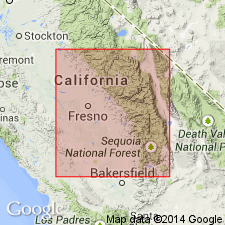
- Usage in publication:
-
- Isabella granodiorite
- Modifications:
-
- Original reference
- Dominant lithology:
-
- granodiorite
- AAPG geologic province:
-
- San Joaquin basin
Summary:
Pg. 343-352. Isabella granodiorite. A large, generally massive, rather variable intrusive body consisting mainly of granodiorite. Grades into granite, also through quartz diorite into diorite. Is distinctly younger than the gabbro diorite that cuts Kernville series. May be Late Jurassic. It more or less intricately cuts Kernville series and the intrusive gabbro diorite.
Typical occurrence in vicinity of Isabella, Kernville quadrangle, Kern Co., southern CA.
Source: US geologic names lexicon (USGS Bull. 896, p. 1027).
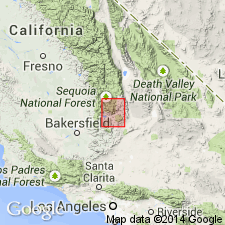
- Usage in publication:
-
- Isabella granodiorite
- Modifications:
-
- Overview
- AAPG geologic province:
-
- San Joaquin basin
Summary:
Pg. 357-358, 378 (fig. 31), pl. 2. Isabella granodiorite. Shown on map and columnar section as Jurassic(?).
Source: US geologic names lexicon (USGS Bull. 1200, p. 1889).
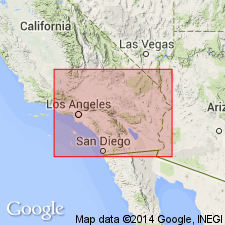
- Usage in publication:
-
- Isabella granodiorite
- Modifications:
-
- Areal extent
- AAPG geologic province:
-
- San Joaquin basin
Summary:
Pg. 512, table 4. Isabella granodiorite. Late Mesozoic.
Source: US geologic names lexicon (USGS Bull. 1200, p. 1889).
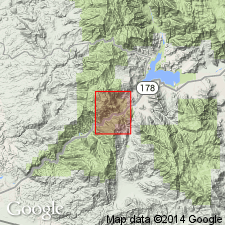
- Usage in publication:
-
- Isabella granodiorite
- Modifications:
-
- Geochronologic dating
- Age modified
- AAPG geologic province:
-
- San Joaquin basin
Summary:
Pg. F181-F189, pls. Isabella granodiorite. Lead (Pb)-alpha age determinations range from 85 to 96 million years. Average age is 90 million years, nearly equivalent to beginning of Late Cretaceous epoch. Younger than Kernville series.
Source: US geologic names lexicon (USGS Bull. 1200, p. 1889).
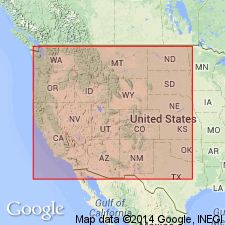
- Usage in publication:
-
- Isabella Granodiorite
- Modifications:
-
- Geochronologic dating
- AAPG geologic province:
-
- San Joaquin basin
Summary:
Pg. 9, geologic time scale (inside front cover). Isabella Granodiorite of Miller (1931). Sample from Lat. 35 deg. 34 min. 00 sec. N., Long. 118 deg. 34 min. 00 sec. W., Miracle Hot Springs quadrangle, Kern County, California, yielded a Pb-alpha age of 100 +/-10 Ma (zircon) [Cretaceous]. Age published by Marvin, 1968 (USGS Misc. Geol. Inv. Map I-537). Age calculated using decay constants of Steiger and Jager, 1977 (Earth Planet. Sci. Letters, v. 36, p. 359-362). Jaffe and others, 1959 (USGS Bull. 1097-B) reported Pb-alpha ages of 83, 89, and 96 Ma for similar zircon concentrates from same locality.
Source: Publication.
For more information, please contact Nancy Stamm, Geologic Names Committee Secretary.
Asterisk (*) indicates published by U.S. Geological Survey authors.
"No current usage" (†) implies that a name has been abandoned or has fallen into disuse. Former usage and, if known, replacement name given in parentheses ( ).
Slash (/) indicates name conflicts with nomenclatural guidelines (CSN, 1933; ACSN, 1961, 1970; NACSN, 1983, 2005, 2021). May be explained within brackets ([ ]).

